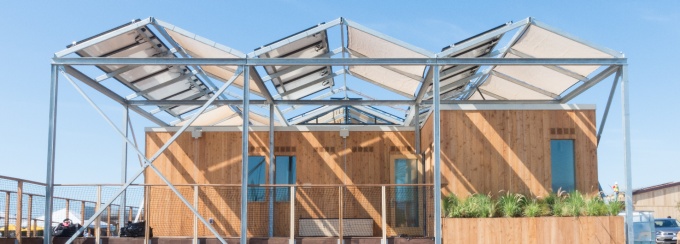REV Campus Challenge
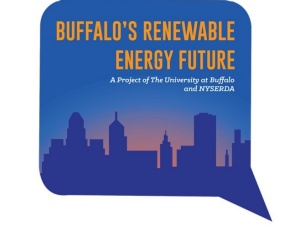
A renewable energy initiative being spearheaded by UB — and made possible through funding from New York State — aims to invest in the region while reducing energy costs for a who’s who of Buffalo-area anchoring institutions (The City of Buffalo, Erie County, The University at Buffalo, Buffalo State College, and SUNY Erie). It could also help save taxpayer dollars while creating more efficient budgeting for the participating institutions.
It’s called Localizing Buffalo’s Renewable Energy Future, and the plan calls for the creation of 100 megawatts of renewable energy- enough to provide 50% of renewable energy for participating partners, mostly in the form of solar power, by 2020.
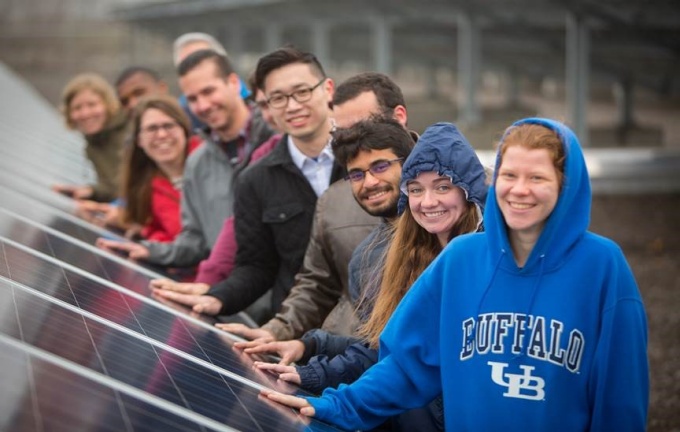
Scaling Renewable Energy
Key to the process is what’s known as a power purchase agreement, or PPA. It’s a different, more cost-effective way for large energy users to purchase power. For many bigger institutions, like a city or a university, annual energy costs are unpredictable and uncontrollable because the electricity rates vary depending on the market. Utility costs can fluctuate, but generally increase over a period of years.
A PPA, however, is a contract that locks in a fixed energy price over an extended period of time, anywhere from 10 to 30 years. That means that the buyer purchasing the power — in this case, Buffalo, Erie County and several colleges — will be able to know for a long time exactly what their energy costs will be, and can budget accordingly.
Progress
- RFP Developed for Solar Consulting Services- July 24th, 2017
- Solar Consultant (Edison Energy) Hired - October 18th, 2017
- Kickoff meeting for five key stakeholders (City of Buffalo, Erie County, SUNY Erie, Buffalo State College, and the University at Buffalo) led by Edison Energy- November 2nd, 2017
Milestones
- Each stakeholder has committed to individual institutional goals of sourcing at least 50% of their respective loads from renewable energy through this PPA assuming favorable price points are attained
- 260 potential "behind-the-meter" sites (including ground, roof, and parking canopies) have been identified
- 83 preliminary on-site locations have been identified as viable
GRoW Home
The GRoW (Garden, Relax or Work) Home was the University at Buffalo’s entry into the U.S. Department of Energy’s Solar Decathlon 2015. It is an international competition held every two years where 20 collegiate teams are invited from around the world to design, build, operate and market an ultra-efficient home.
The competition challenges teams to develop a sustainable project that performs well in 10 individual contests, ranging from Architecture and Engineering excellence, to Market Appeal and Energy Balance. Through their efforts, over 200 students and faculty from 13 departments across five separate schools from two universities came together to develop a comprehensive proposal to represent Buffalo on an international stage. Through this extremely rare opportunity, the students were able to work in a highly collaborative and vastly interdisciplinary fashion to gain real world experience through a common objective all before they graduate. In this manner, the GRoW home serves as an ideal model to bridge the gap between research-based academia and practice-based industry.
Through the funding received from REV, the GRoW Home is permanently housed on UB's North Campus. It is a student engagement space for direct or curricular and experiential learning activities related to clean energy. It can also be used for a meeting space for sustainability oriented groups on campus, as well as local non-profits focused on clean energy. Continuing the educational dimension of the GRoW Home, the house would be opened to K-12 schools, as well as college students outside UB, professional organizations and community groups for tours and events.
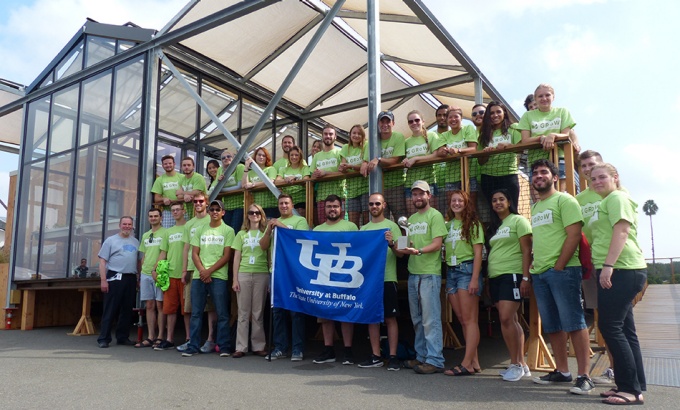
Progress
- The GRoW home is unpacked on UB's South Campus in exhibition mode- November 2017
Milestones
- An architecture and planning studio led by Dr. Martha Bohm in Fall 2017 developed a set of criteria for siting the GRoW home next to the Solar Strand on North Campus. Using this criteria, they have selected a permanent site suitable for the center.
- Two students are working with University Facilities to prepare the site for its installation.
GRoW Home Opened on South Campus in Exhibition Mode [2:00]
Expanding Curriculum and Creating Change Agents
While moving towards climate neutrality is a key piece of UB’s sustainability strategy (as well as Buffalo State and Erie Community College)—it is secondary to the goal of creating sustainably literate and engaging students who will work throughout their professional and personal lives to create a better tomorrow. This initiative, seeks to leverage this priority in two key ways:
- identify and act on opportunities to integrate clean energy principles into curriculum
- Facilitate knowledge transfer throughout experiential learning to the campus and broader community
One way to achieve this is to utilize our own operations as a pedagogical teaching tool because learning by study is important, but learning by doing with instruction is more effective. What this initiative seeks to accomplish is creating a pool of engaged students who help mold and shape the initiative, provide the fuel and energy to assist in building a truly integrated program and pass on their knowledge and shared experience to the broader student community.
Along with curriculum and course work, this project will focus on two areas of engagement. The first is the internal engagement at the University at Buffalo. This constitutes current and former students, faculty, and staff that are all a part of the campus community. Engaging students can be on an individual level through classes, coursework and experiential learning, or it can be through student clubs, external engagement and academic groups.
The second area of engagement is for the Western New York region at large. Buffalo-Niagara has a population of about 1.2 million people, therefore engagement must be strategic. The region has a breadth of organizations and institutions doing great work within communities already. The types of external stakeholders that will be engaged are; other universities and colleges, governmental agencies, schools, non-for profits, and neighborhood residents.
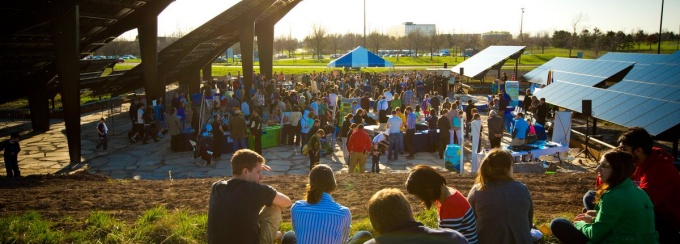
Progress
- Student Curriculum and Learning Plan created - May 2017
- Internal and External Engagement Plan created- June 2017
Milestones
Curriculum Developments
- Studio on siting the GRoW Home on North Campus developed.
- Created a seminar on how to develop an on campus solar inventory.
Student Work
- Conducted a Buffalo Solar Inventory of possible vacant lots to place solar panels in an Architecture and Planning studio entitled "Vacant to Viable."
- Examined key legal issues associated with solar siting through the UB Law School’s Environment Advocacy clinic.
- Developed a clean energy literacy survey for students across campus.
- Created a database of local organizations and internship ideas.
- Created a brand guide for marketing and communicating the Localizing Buffalo's Renewable Energy Future initiative.
On-Campus Engagement
- Clubs with an environmental focus have briefed on the Localizing Buffalo's Renewable Energy Future initiative.
- Clean energy research was supported through the Center for Undergraduate Research and Creative Activities culminating at the Celebration of Academic Excellence.
Off-Campus Engagement
- Preliminary talks with local organizations involved with solar and clean energy held with the intent to develop a solar consortium of experts and community members.
